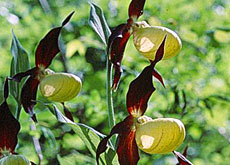
Growing threat to plant and animal life

Switzerland has little to celebrate on International Day for Biological Diversity on Thursday.
The number of plants and animals on the Red List of Threatened Species has risen in the last ten years.
Meanwhile, more and more land is being swallowed up for development.
“If you compare the situation in Switzerland with other countries in Europe, there is a higher percentage of species on the Red List,” said Urs Tester, head of the biodiversity team at Switzerland’s largest conservation organisation, Pro Natura,
“That’s to say, they are declining or on the way to extinction, so in Switzerland we really have a problem with the protection of species.”
Many types of reptiles and fish are facing extinction in Switzerland. Over 80 per cent of reptile species, for example, are on the Red list.
“In Switzerland you have a lot of different habitats and a lot of different climate zones, so you have a high number of species in a small area,” Tester told swissinfo.
“Combined with this, you have the high pressure of land use.”
Decline
Erich Kohli of the Swiss Environment Agency agreed that there has been a regression over the last few years.
“There are still more animal and plant species in the Red Lists than ten years ago, so despite all the work done with nature protection, conservation and so on, we are still not successful.”
Globally, about 40 per cent of animal species are listed and 34 per cent of plant species. For ferns and mosses, the figures are 41 per cent and 18 per cent respectively.
“For a well developed country with a high population density, we rank with other countries or perhaps a little bit worse,” said Kohli “OECD ratings on nature protection show Switzerland is a little bit worse than other European countries.”
“The pressure of population, of construction, of roads and also free time tourism is very, very high in Switzerland so we have difficulties finding the space for animals and plants.”
Birdlife
Some 190 species of bird breed regularly in Switzerland and about 40 per cent of theses are endangered.
However, the picture is more complicated than Red Lists allow. For example, the total number of species of breeding birds in Switzerland has increased in the last 100 years.
During the same period, the number of widespread species like the house sparrow has declined by over one third.
Pro Natura is trying to implement special programmes for the most endangered species on the Red List like butterflies and tree frogs, while Birdlife Switzerland and partner organisations have concentrated on the 50 most threatened birds.
Although there have been some regional successes, nationally the picture shows ground lost.
“We need sufficient means and political will to see it through,” said Christa Glauser, spokeswoman for Birdlife Switzerland.
Alpine habitat
Three years ago in June, some 70 scientists went up to an Alpine meadow in canton Graubünden and documented as many plants and animals as they could find in a 24 hour period.
They found some 2,000 species. One of the main people behind the project was Jürg Müller, director of the natural history museum in Chur.
Müller believes that there are as many as 10,000 species in the high mountain habitat waiting to be discovered and is more optimistic about species numbers than many of his colleagues.
“I think it is dangerous with all these lists of endangered species because we talk always about birds, about mammals, about butterflies and about some plants but we forgot all about the smaller species,” he said.
“We are trying to find out whether it is really true what we say about endangered species when we look at the earthworms and the beetles and other species as well.”
swissinfo, Vincent Landon
Estimates of the number of known species worldwide vary from 1.5-2.5 million.
The number of anticipated species varies from five to 30 million.
Very little is known about 99 per cent of known plants and animals,.
According to some estimates, at least a third of all species will die out in the next ten to 20 years.

In compliance with the JTI standards
More: SWI swissinfo.ch certified by the Journalism Trust Initiative




























You can find an overview of ongoing debates with our journalists here . Please join us!
If you want to start a conversation about a topic raised in this article or want to report factual errors, email us at english@swissinfo.ch.